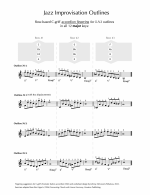As I learn CBA, I've been trying to work in ideas and exercises from Bert Ligon's excellent book, Connecting Chords with Linear Harmony (1996). One of Ligon's recommendations is to practice three common jazz ii-V-I outlines in all keys.
I made a little worksheet with row-based CBA fingering (C-system) to help me internalize these outlines and practice moving each one through all 12 major keys.
A couple of notes:
I made a little worksheet with row-based CBA fingering (C-system) to help me internalize these outlines and practice moving each one through all 12 major keys.
A couple of notes:
- Each outline can be extended from two bars to four (eg, quarter notes instead of eighth notes: | ii7 / / / | V7 / / / | Imaj7 / / / | / / / / |)
- Practice with metronome click on beats 2 & 4
- Fingering indications are often personal choices and/or developed together with teachers. Feel free to change!



